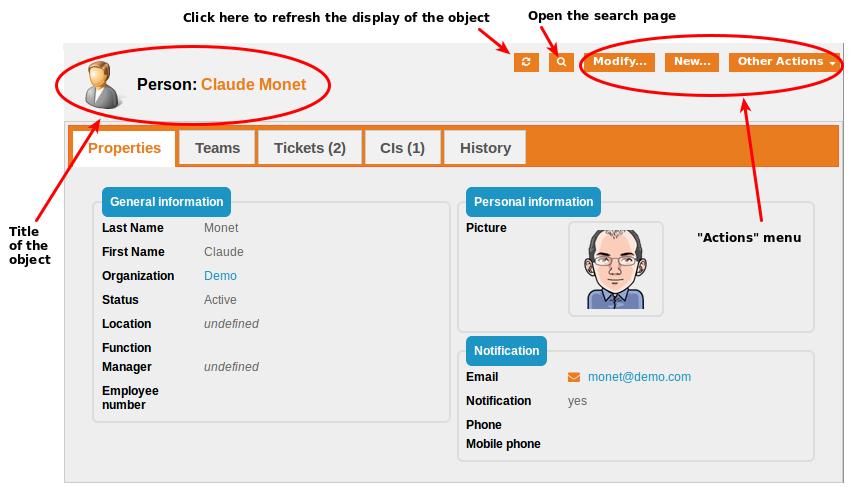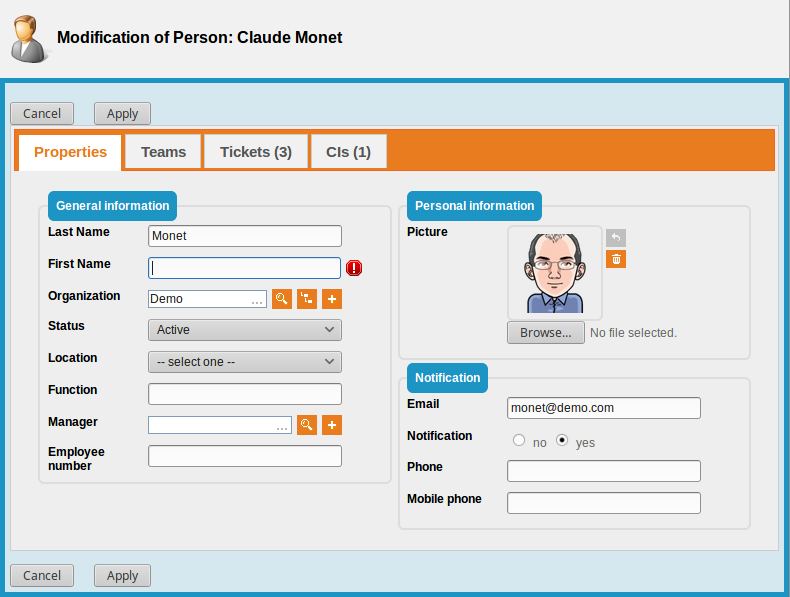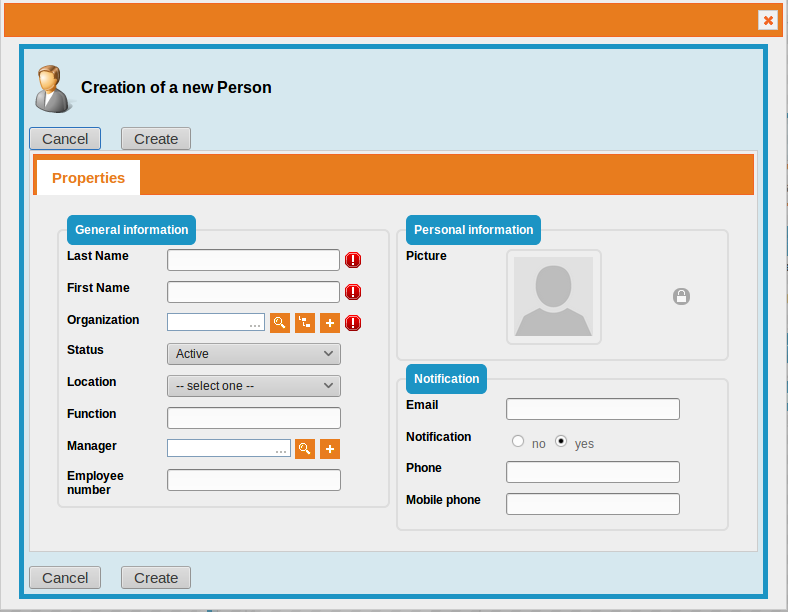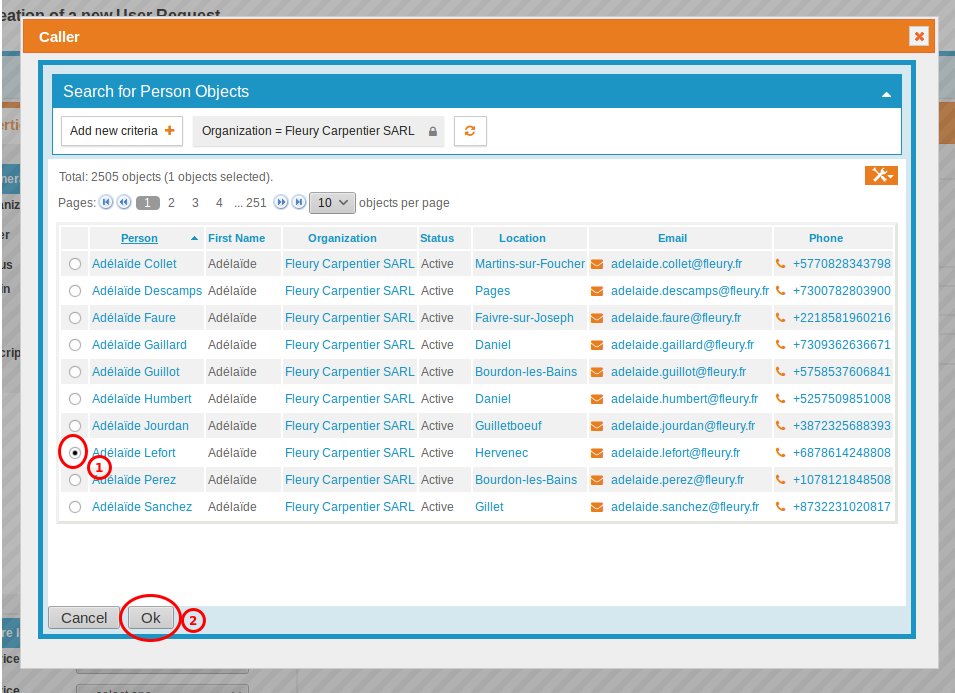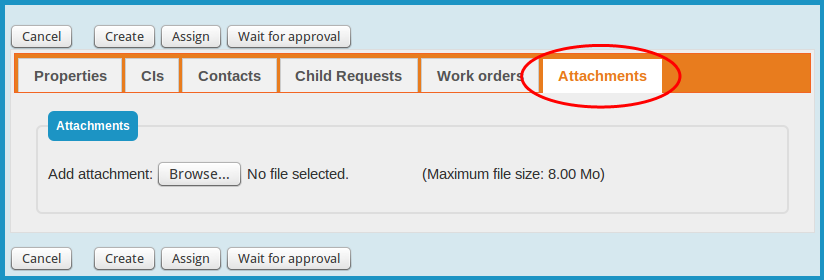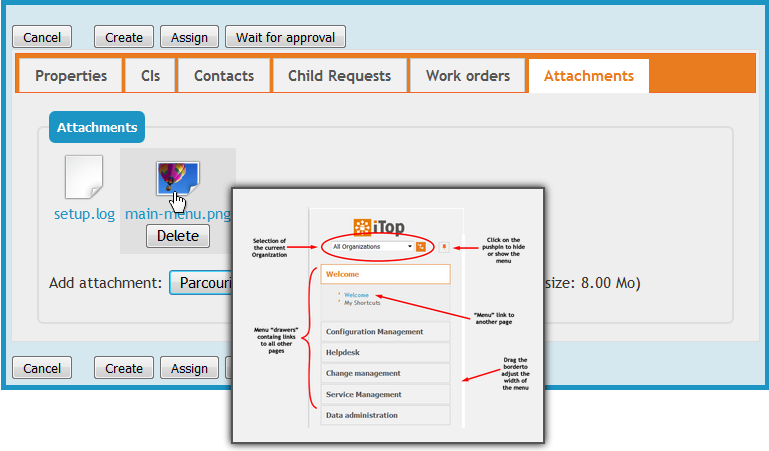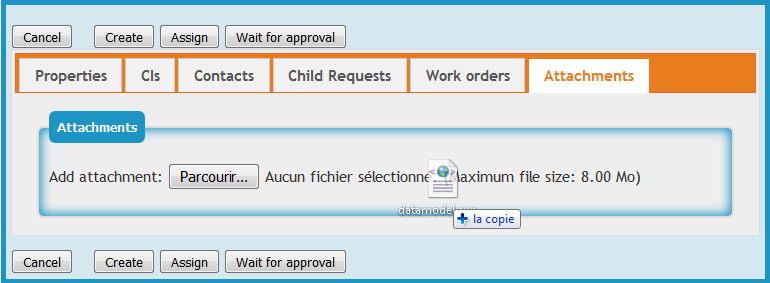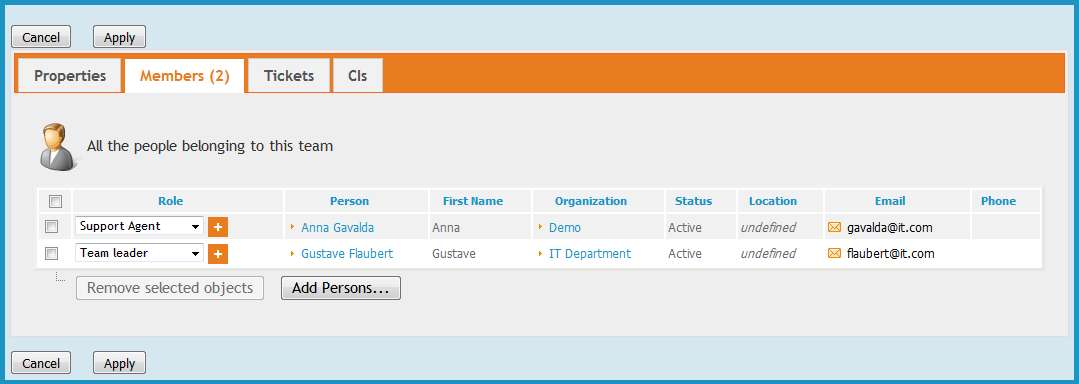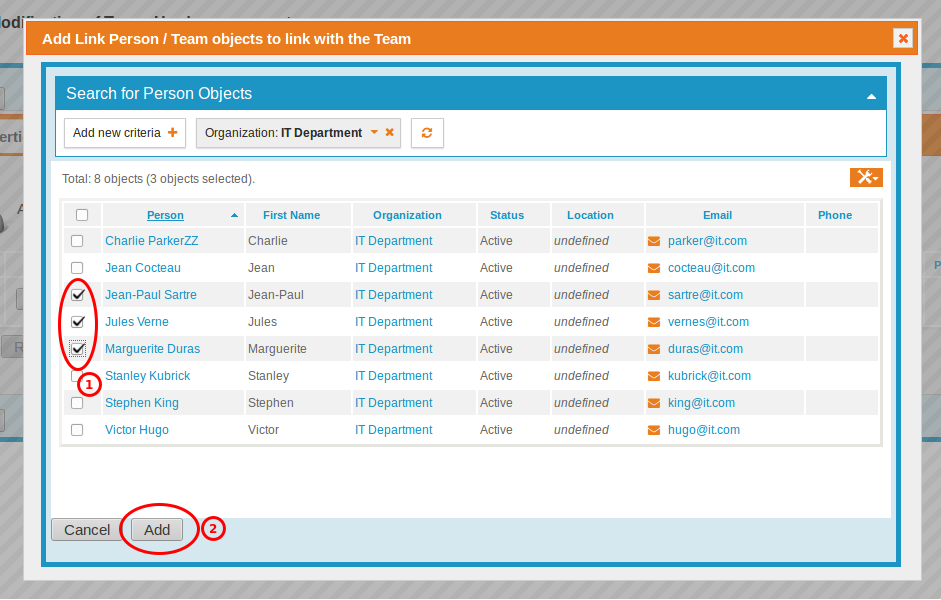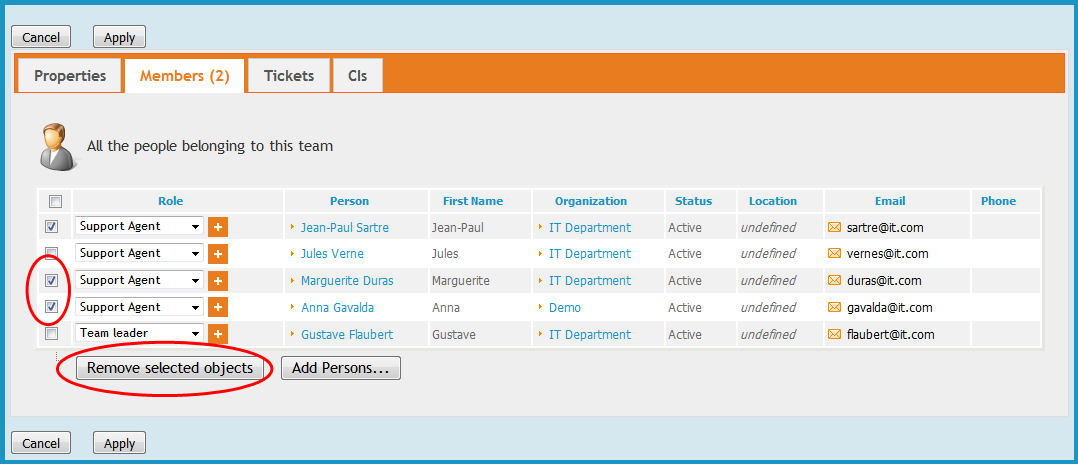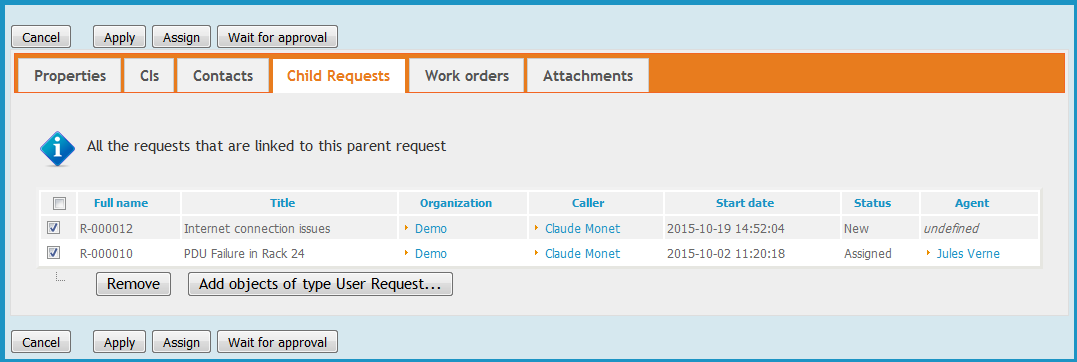Display and Modification of an object
Display
The details of an object are always displayed in the same manner in iTop, as shown below:
The title area contains the icon representing the given class (or type) of the object followed by the class (Person in this case), followed by the actual name of the object.
The blue Search tab (at the top of the page above the title), toggles the display of the search form for this class of object.
The actions allowed for this object are listed as orange buttons (at the top-right of the page). The most frequent actions are displayed as buttons. The remaining actions are accessible via the popup menu Other Actions.
The Properties tab displays the actual properties of the object.
The History tab displays the history of all modifications performed on this object (who modified what and when).
Depending on the class of the object displayed (Tickets for example), an extra Notifications tab may be available, showing all the notifications sent in response to events on this object.
The other tabs display the relationships between the selected object and other objects in the database.
For example, the tab Teams displays all the teams for which the selected person is a member of. The Tickets tab displays the tickets for which the selected person is the requester.
Modification of an object
To modify an object, click on the Modify action, from the details of the object (The same action is also available on a list containing only one object).
The form used to modify an object is quite similar to its details. The only difference is that the fields are editable. For example, the form to modify a Person is displayed as shown below:
Note the small red exclamation mark icon ( ) next to the First Name. This
icon appears when a mandatory field is left blank, or when a field
does not follow the expected format for the field (for example for
an email address). The modifications to the object can only be
saved (using the Apply button) if all the fields
are properly filled.
) next to the First Name. This
icon appears when a mandatory field is left blank, or when a field
does not follow the expected format for the field (for example for
an email address). The modifications to the object can only be
saved (using the Apply button) if all the fields
are properly filled.
For some of the fields, the value is not a free-text but instead must be picked from a drop-down list:
The treeview button ( ) is available
for values that are organized as a hierarchy.
) is available
for values that are organized as a hierarchy.
The plus button ( ) is a shortcut to
create an object and add it to the list. The button is only
available for users who are allowed to create this type of object.
For example, when creating or modifying a ticket, click on the
(
) is a shortcut to
create an object and add it to the list. The button is only
available for users who are allowed to create this type of object.
For example, when creating or modifying a ticket, click on the
( ) button of the field
Caller. The form is displayed to enable to create
a new Person:
) button of the field
Caller. The form is displayed to enable to create
a new Person:
When the number of possible values for a given field exceeds a configured value (50 by default), the drop-down list is replaced by an autocomplete field, as shown below:
Type at least three letters to trigger the search and
pick from the list of objects matching the typed letters, or use
the magnifying glass button ( ) to open a searchdialog:
) to open a searchdialog:
The search dialog lists all the objects. To narrow the search you can use the form at the top before selecting an object and clickon Ok to return to the main form.
Handling Tickets Attachments
Attachments allow to upload a document (any file or image) into iTop and “attach” it to a given object in iTop. This is very similar to email attachments.
To manage the attachments to a Ticket, click on the Attachments tab while creating or modifying a Ticket:
To upload a new attachment, click on the Browse button and select the desired file. Note that the maximum size for a single uploaded file is displayed next to the Browse button. If a file is bigger than this value, it cannot be uploaded into iTop. This maximum size depends on several settings on the server and can be changed only by an administrator.
Once attachments have been uploaded they are listed in the tab, with one icon per file. The name of the attachment is an hyperlink to download it.
Move the mouse above an icon to display the “Delete” button. Clicking on Delete will then remove the attachment from the ticket.
When the attachments is an image, then a preview will be shown anytime the mouse moves over the attachment icon.
Drag and drop
Attachments can also be added by performing a drag drop of the files to attach, directly over the browser's window. When files are dragged over the “Attachments” tab, a blue shadow appears around the area where attached files are normally displayed:
If the “Attachments” tab is not the active one when dragging, files can still be attached to the ticket and the tab itself shows the blue shadow during the drag operation:
Managing Objects Relations
In iTop most of the tabs displayed on the details of an object represent relations between objects. All these relations are managed in the same manner. For example the form to manage the members of a “Team” looks like as shown below:
In order to add members to the team, click on the “Add Persons…” button at the bottom. This displays - as a popup - the search form to select Persons. Check the desired persons in the list and click “Add” to go back to the main form.
You can narrow the search using the criterias at the top, then
click on the  button to refresh the list.
button to refresh the list.
To remove objects from the relation, check the corresponding line in the form, then click on the “Remove selected objects” button at the bottom.
On Tickets, a slightly different type of relation is available where the related objects are other tickets.
To detach related tickets from the current ticket, just select them by checking the corresponding checkbox and click on “Remove”.
You can use the “Add objects of type…” button to relate other Tickets to the current Ticket. When clicking on the button, a popup dialog is displayed with the standard search form at the top and a list with check boxes at the bottom:
You can use the  button to refresh the list after
changing the filtering criteria at the top. Make your choice by
checking the corresponding checkboxes, then press the “Add” button
to dismiss the dialog.
button to refresh the list after
changing the filtering criteria at the top. Make your choice by
checking the corresponding checkboxes, then press the “Add” button
to dismiss the dialog.

